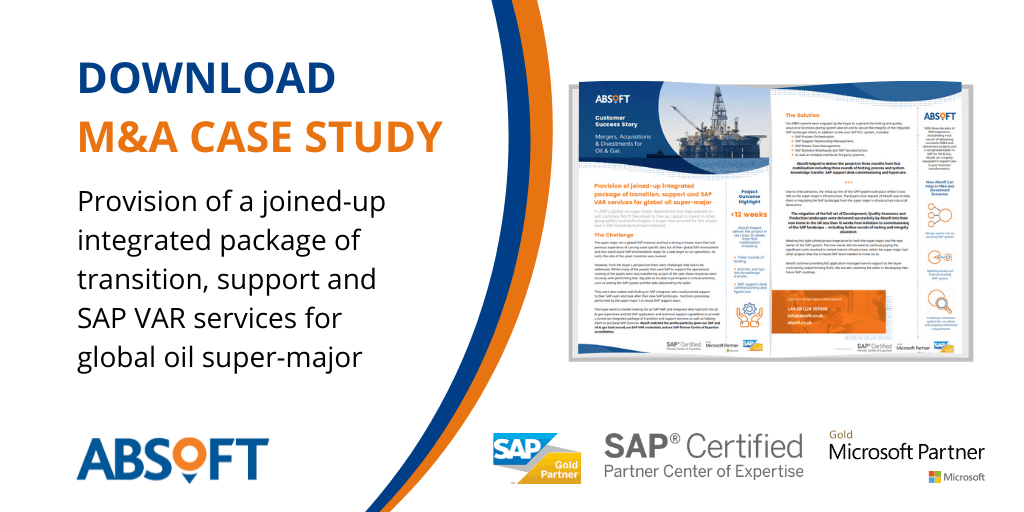It is crucial that during an SAP Mergers and Acquisitions (M&A) transition both, the needs of the buyer and the seller, are met. The IT and ERP migrations should be seamless and not hinder the realisation of the revenue and income associated with the deal. What does that entail?Â
In this blog post, Don Valentine, Absoft Director details the typical requirements of the stakeholders involved and how to meet all parties’ needs and demands.
Â
SAP Mergers and Acquisitions in 2021
Cast an eye over the major accounting firms’ expectations for M&A activity in the UK in 2021 and you will find a consistent and optimistic story. They all expect the strong Q4 2020 showing to continue and accelerate into 2021.
This is not only expected in markets that have thrived, but also in those that have flatlined, in the past year. Oil & Gas expects to be one of those markets in which M&A activity will be in the ascendancy. This is because of an uptick in oil prices and the belief they will remain stable in the future. The global economy moving through the gears of recovery will further augment this.
If M&A activity is on the up, what does that look like in the upstream Oil & Gas sector?
Absoft’s preview is that the ongoing sale of UKCS assets by the oil majors will continue. This will fuel the growth of a new tranche of emerging operators as well as the emergence of new players into the market. Furthermore, we expect there will be ongoing consolidation of assets within that emerging operator base.

The Key Players in an SAP Mergers and Acquisitions Project
As a Commercial Director of an IT services company with a 30-year history of supporting the Oil & Gas sector I regularly have to place myself in the shoes of both the buyer and seller organisation. This way I can anticipate correctly how we can help them make the IT workstream of an (SAP) mergers and acquisitions transition as seamless as possible.
In this post, I outline the perspective of the
- Chief Executive Officer,
- Finance Director,
- Operations Director,
- and the IT Director.
In a series of blog posts to follow this one, I will delve further into the transition requirements of individual functions – Maintenance, Supply Chain, HR.
This article focuses on both the buying and selling organisations’ aims when delivering the IT workstream of the transition. (Note: The premise of this blog is an SAP Mergers and Acquisitions event involving an operator)
The Buyer Organisation in an M&A Scenario
What does the management team in the buyer organisation need from the IT transition?
CEO and Finance Director
Two items will be at the top of the CEO and Finance Director’s agenda
- They will want to get the deal done in the prescribed time. Naturally, they expect stakeholders to meet the commitments and wider market performance targets they’ve agreed on. These revenues will be reliant on the completion of integration and the deal itself. In other words, a delay to the completion of the integration will not be welcome! Completion of integration ties in with the Sales & Purchase Agreement (SPA) between the buyer and seller. Delays to this have market-facing implications and added costs of extending the SPA.
- They will want no IT-related disruption. In particular, a disruption that compromises asset safety, production, or efficiency. Anything impacting the confidence of Joint Venture partners simply can’t happen.
Operations Director
The Operations Director will share the concerns of the CEO & Financial Director. However, they will also have operations-specific needs.
- Retaining mission-critical data will be a primary requirement. The business must also not drawn into extensive IT testing activities. Any period when IT systems are unavailable during the transition also needs to be minimised. Elaborating further, the Operations Director will want assurances key data is available post-transition. Data such as maintenance history and maintenance SOP’s in particular. Additionally, stock movement history – especially for critical spare parts – will be of interest.
- The transition will consume time and energy across the business. As a result, resources in the organisation will be stretched. The Operations Director will be aware of this. Any request to dedicate resources to testing IT systems will be a red flag for the Operations Director.
- The blackout period during which IT systems are unavailable will also be a focus for Finance and Operations Directors. Elongated periods of surviving on spreadsheets and workarounds will not be welcome. The Operations Director will want to see evidence early in the integration process that the IT systems are ready for the transition.
The Operations Director’s primary goal is to ensure smooth and safe operations. They will want to see ongoing evidence that the IT workstream is on the right track. Progression towards the IT transition must be transparent and give confidence that disruption will be minimal.
Chief Information Officer or IT Manager
The buying Chief Information Officer or IT Manager wants a smooth transition with the Mergers and Acquisitions project. This is in respect to the “no disruption” goal of their senior leadership team. They will also have an eye on the future of their new IT landscape.
They will be looking to ensure the transition is delivering a landscape that has no near-term obsolescence issues. That is to say where licensed software, operating systems, databases, and hardware are under maintenance well beyond the integration date. They don’t want to embark on a mandatory upgrade project immediately after completing a challenging transition project.
The CIO will also want to receive a landscape that is fit for purpose and with any bloat removed. For example, if the buyer has an existing strategic data warehousing solution and the seller landscape also has a data warehouse. The CIO will want that data warehouse removed from the landscape provided in the transition.
Of course, there are reasonable limits to what the buyer CIO can expect the seller to do under the auspices of the transition. In particular, changes related to the delivered solution being aligned with the buyer’s IT strategy are typically handled in a subsequent buyer-specific project.
The Seller Organisation in an M&A Scenario
Changing hats to consider the perspectives of the same roles but from the Sellers perspective.
CEO and Finance Director
The CEO and Finance Director on the selling side have similar objectives to their peers in the buyer organisation.
- They will have promised markets and shareholders timebound investments. This is often predicated on realising the capital from the sale. So, getting the sale done on time will be high on their agenda.
- Again, like their buyer peers, the CEO and Finance Director will want no IT-related disruption. They want to avoid compromising asset safety, production and efficiency. The confidence of the Joint Venture partners is also of utmost importance. Being seen to offer safe and robust transitions is important for market confidence. This is especially true when it comes to selling other assets. Therefore, it is important to the CEO and Finance Director who may have planned subsequent asset sales in the future.
- One area which will be of specific interest to the Finance Director will be sensitive data. The buyer will want maintenance and supply chain data included in the transition. However, there will be some data that the seller does not wish to share and indeed must not provide to the buyer. Financial history, sensitive commercial data, and HR data is usually excluded. The Finance Director will want evidence that this data has not been included in files or systems provided to the seller. The Finance Director typically delegates the responsibility for gatekeeping sensitive data to the CIO.
Operations Director
The Operations Director in the selling organisation wants the transition to have a minimal impact on the ongoing operations of the retained business. For them, the IT transition of systems and data has to be an IT event, not something that consumes operational resources.
Chief Information Officer
The seller CIO has a slightly more complex set of requirements. They share the straightforward objective of their Operations Director and have ongoing delivery commitments to the retained organisation. As a result, they also have an interest in minimising IT resources dedicated to the transition.
However, the Finance Director will want the CIO to ensure the transition is efficient and successful. They want to promote positive market sentiment. Also, they want IT to make sure that data sensitivities are respected in the transition. The seller CIO must find a path to continue to deliver IT services into the retained business, whilst also delivering a successful, on-time transition.
Completing the integration and therefore, the IT transition, within the period of the SPA is critical to the CIO. There may be a superficial upside to a delayed or extended SPA scenario (more revenues to be earned by the seller as the buyer is forced to extend the use of the seller’s IT infrastructure and systems) – but the CEO and FD will be less than impressed by this nominal benefit.
Another important IT consideration for the selling CIO is minimising the buyer’s access to their IT network. During the transition, the buyer needs access to systems and data to test if the solution is fit-for-purpose. However, the selling CIO will not want external organisations coming into their network to test the solution, as it is in preparation.
As such, a mechanism is required which allows the buyer to test the solution that does not involve requiring access to the seller’s network. We will address this need and the solutions in our following blog posts from this series.
Next Blog Posts – M&A Transition Requirements of Individual Functions
In a series of blog posts to follow, I delve further into the transition requirements of individual functions. This will include: Operations & Maintenance, Operations & Supply Chain, Finance, IT, and HR. The blog post series will investigate how we achieve requirements across the lifecycle of the transition. We will address Day 0 (deal signature date), Day 1 (deal close date), Day 2 (End of Integration), and Day 3 (Implementation of the Future State).
Follow Absoft on LinkedIn to keep up to date with our ongoing SAP Mergers and Acquisitions blog post series.
Blog post by Don Valentine, Absoft’s Commercial Director.










